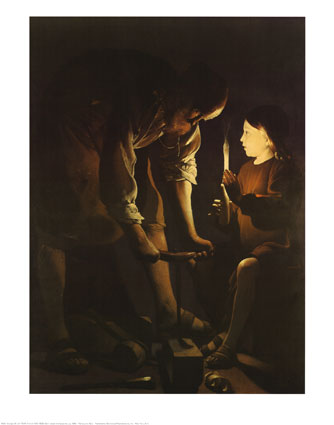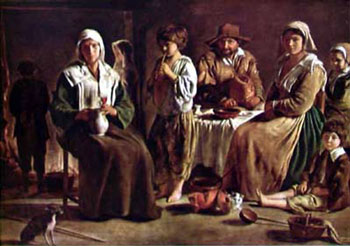

French BaroqueThe Art and The ArtistsLate Mannerism and Early Baroque
Henri IV also invited the artists Toussaint Dubreuil, Martin Fr�minet and Ambroise Dubois to work on the ch�teau of Fontainebleau and they are typically called the second School of Fontainebleau. Marie de Medicis, Henri IV's queen, invited the Flemish painter Peter Paul Rubens to France and the artist painted a number of large-scale works for the queen's Luxembourg Palace in Paris. Another Flemish artist working for the court was Frans Pourbus, the Younger. The period of the early 17th century shows influences from both the north of Europe and from Roman painters of the Counter-Reformation.
Artists in France frequently debated the merits between Peter Paul Rubens, the Flemish baroque painter who used voluptuous lines and colors, and Nicolas Poussin whose style employed rational control, proportion and a Roman classicism.
There was also a strong Caravaggio school represented in the period by the amazing candle-lit paintings of Georges de La Tour.
The second floor North wing of the Sully section of the Louvre has a wonderful exhibition of artists from this period. The Le Nain Brothers and Georges de La Tour's works are displayed and benefit from the natural light from the skylights. Classicism Louis XIV and French Classicism The architecture and the arts in the mid-to-late 17th century in France are most often referred to by the term Classicism, generally implying an adherence to certain rules of proportion and sobriety. The Baroque, as it was practiced in Italy, was not in French taste and Bernini�s famous proposal for redesigning the Louvre was rejected by Louis XIV. Through propaganda, wars and great architectural works, Louis XIV launched a vast program designed for the glorification of France and his name. The Palace of Versailles, initially a tiny hunting lodge built by his father, was transformed by Louis XIV into a marvelous palace for f�tes and parties. Architect Louis Le Vau, painter and designer Charles Le Brun and the landscape architect Andr� Le N�tre created marvels; fountains danced and wandering revelers discovered hidden grottos in the gardens. The initial impetus for this transformation of Versailles is generally linked to the private ch�teau Vaux-le-Vicomte built for Louis XIV's minister of Finance, Nicolas Fouquet. Having offered a lavish festival for the king in the newly finished residence in 1661, the minister was accused of misappropriation of funds and sentenced to life imprisonment. The architects and artists under his patronage were all put to work on Versailles. In this period, Louis' minister Jean-Baptiste Colbert established royal control over artisanal production in France; henceforth, France would no longer purchase luxury goods from abroad, but would herself set the standard for quality. This control was also seen in the creation of an Academy of painting and sculpture which maintained a hierarchy of the genres of painting (the noblest being historical painting), a strong use of pictorial rhetoric and a strict sense of decorum. The furnishings and interiors from this period are referred to as "Louis XIV style", characterized by thick brocades of red and gold, heavy gilt work on plaster moldings, large sculpted sideboards and heavy marbles. Eventually, Versailles was transformed into the official residence of the king (1682); the Hall of Mirrors was built; other smaller ch�teaux, like the Grand Trianon, were built on the grounds; a huge canal featuring gondolas and gondoliers from Venice was created. In his youth, Louis XIV had suffered during the civil and parliamentary insurrection known as the Fronde. By relocating to Versailles, he could avoid the dangers of the capital; he could also keep his eye very closely on the affairs of the nobles and could play them off against each other and against the newer growing French middle class. Versailles became a gilded cage: to leave spelled disaster for a noble, for all official charges and appointments were made there. A strict etiquette was imposed. A word or glance from the king could make or destroy a career. The king himself followed a strict daily program and there was little privacy. Through his wars and the glory of Versailles, Louis became, to a certain degree, the arbiter of taste and power in Europe and both his ch�teau and the etiquette in Versailles were copied by the other European courts. Yet the difficult wars at the end of his long reign and the religious problems created by the revocation of the Edict of Nantes made the last years dark ones. Rococo and Neoclassicism The death of Louis XIV lead to a period of licentious freedom commonly called the R�gence. The heir to Louis XIV, his great grandson Louis XV of France, was only 5 years old. During the next seven years, France was ruled by the regent Philippe II of Orl�ans. Versailles was abandoned from 1715 to 1722. Painting turned toward "f�tes galantes", theater settings and the female nude. Painters from this period include Antoine Watteau, Nicolas Lancret and Fran�ois Boucher. The "Louis XV style" of decoration (although already apparent at the end of the last reign) was lighter: pastels and wood panels, smaller rooms, less gilding and fewer brocades; shells and garlands and occasional Chinese subjects predominated. Rooms were more intimate. After the return to Versailles, many of the baroque rooms of Louis XIV were redesigned. The official etiquette was also simplified and the notion of privacy was expanded. The king himself retreated from the official bed at night and conversed in private with his mistress. The latter half of the 18th century continued to see French preeminence in Europe, particularly through the arts and sciences, and the French language was the common language of the European courts. The French academic system continued to produce artists, but some, like Jean-Honor� Fragonard and Jean-Baptiste Sim�on Chardin, explored new and increasingly impressionist styles of painting with thick brushwork. Although the hierarchy of genres continued to be respected officially, genre painting, landscape, portrait and still life were extremely fashionable. The writer Denis Diderot wrote a number of times on the annual Salons of the Acad�mie of painting and sculpture and his comments and criticisms are a vital document on the arts of this period. One of Diderot's favorite painters was Jean-Baptiste Greuze. Although often considered kitsch by today's standards, his paintings of domestic scenes reveal the importance of Sentimentalism in the European arts of the period. One also finds in this period a kind of "Pre-romanticism". Hubert Robert's images of ruins, inspired by Italian cappricio paintings, are typical in this respect. Also, there was a change from the rational and geometrical "French garden" (of Andr� Le N�tre) to the "English garden", which emphasized (artificially) wild and irrational nature. One finds, in some of these gardens, curious ruins of temples.
A present day example of this can be seen in the Parc Monceau in the 8eme Arrondissement.
Home | Paris Facts | Paris Transportation | Paris Customs | Self Guided Walks | Guided Walks | Paris Hotels | Paris Monuments | Paris Museums | Paris Gardens | Paris Churches | Paris History | Contact Us | French Art | Paris Web Resources | Travel Directory | Paris Tours | Hostels | Travel Insurance | Site Build It! Library
|
||||























